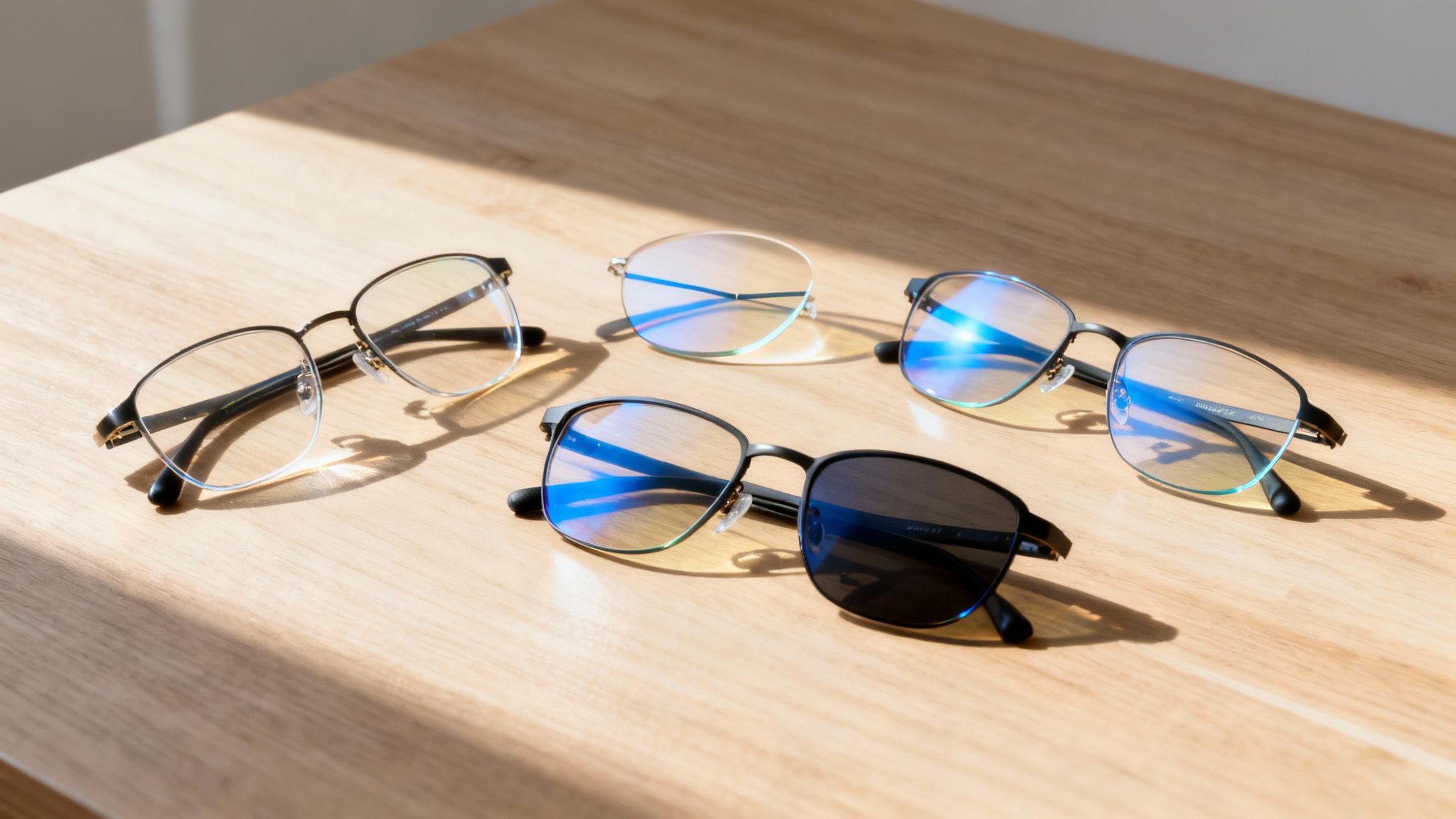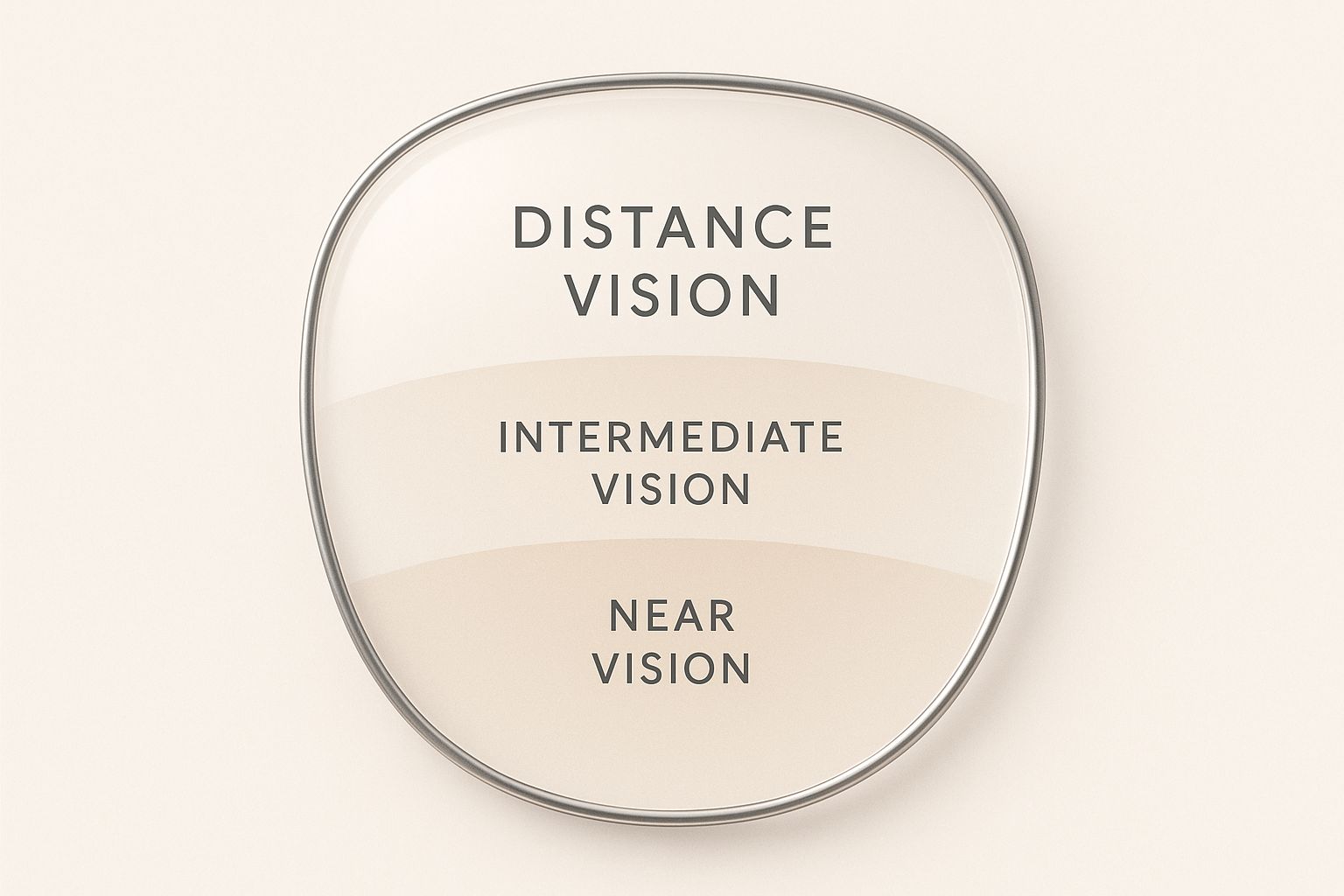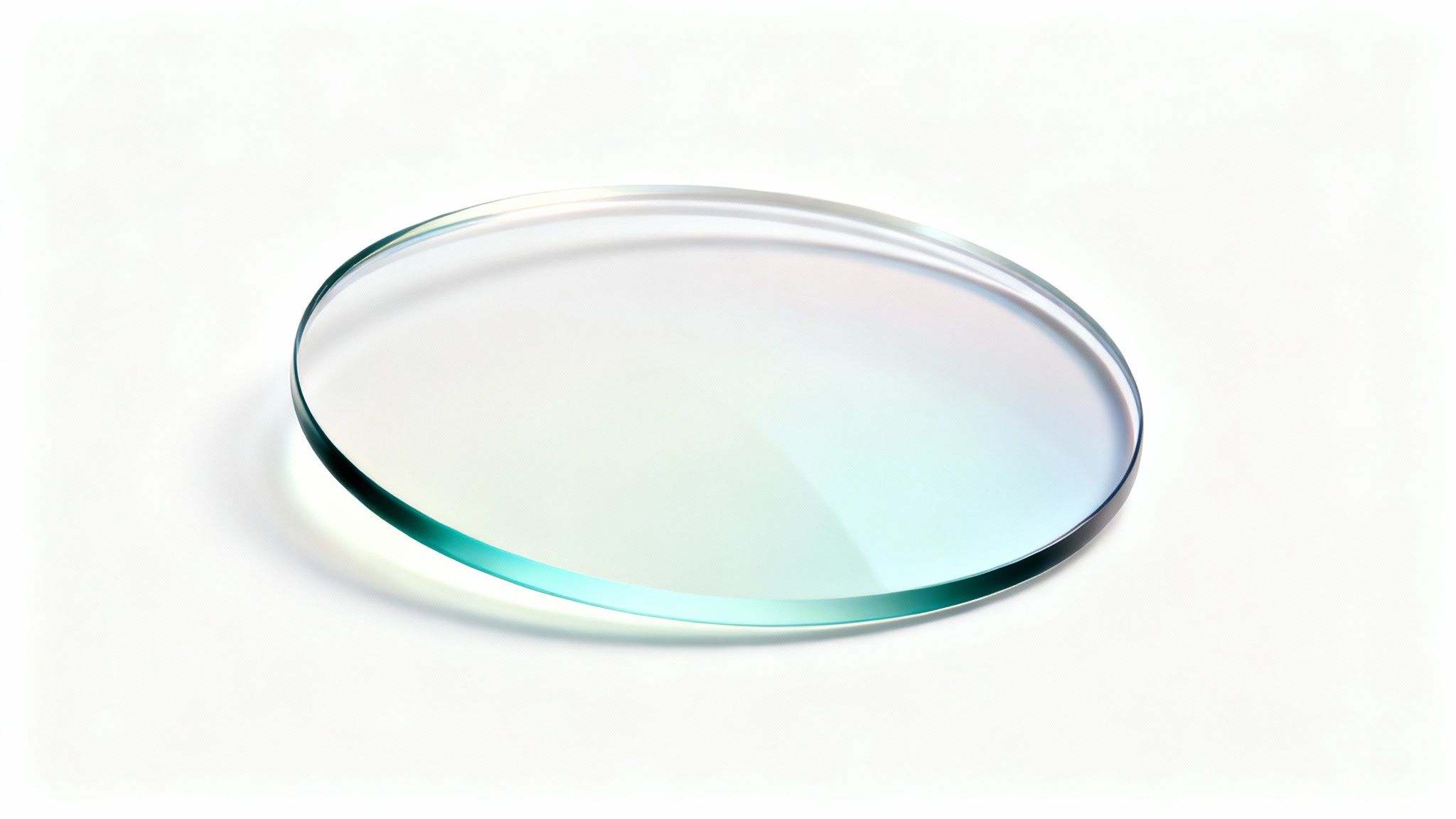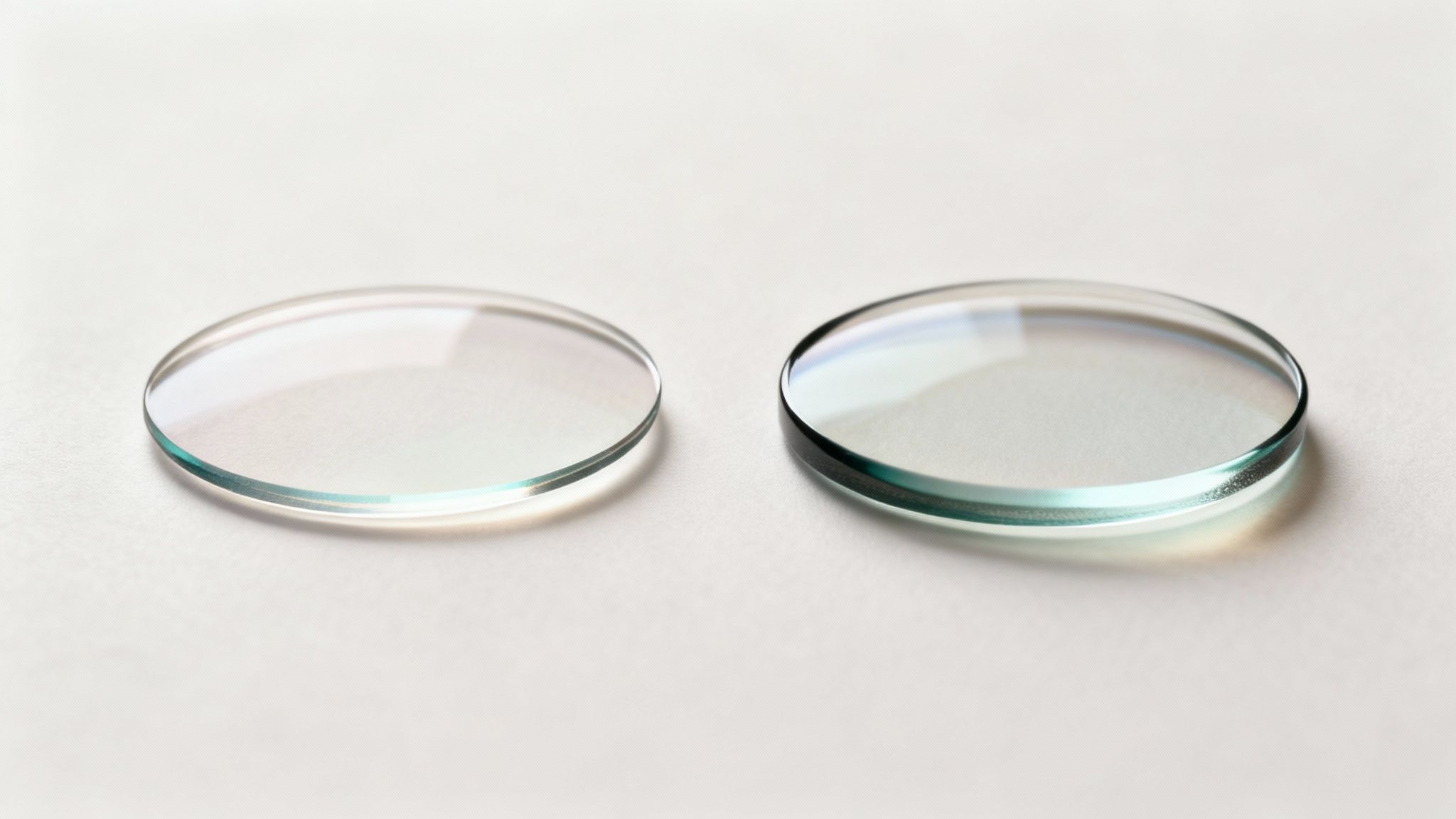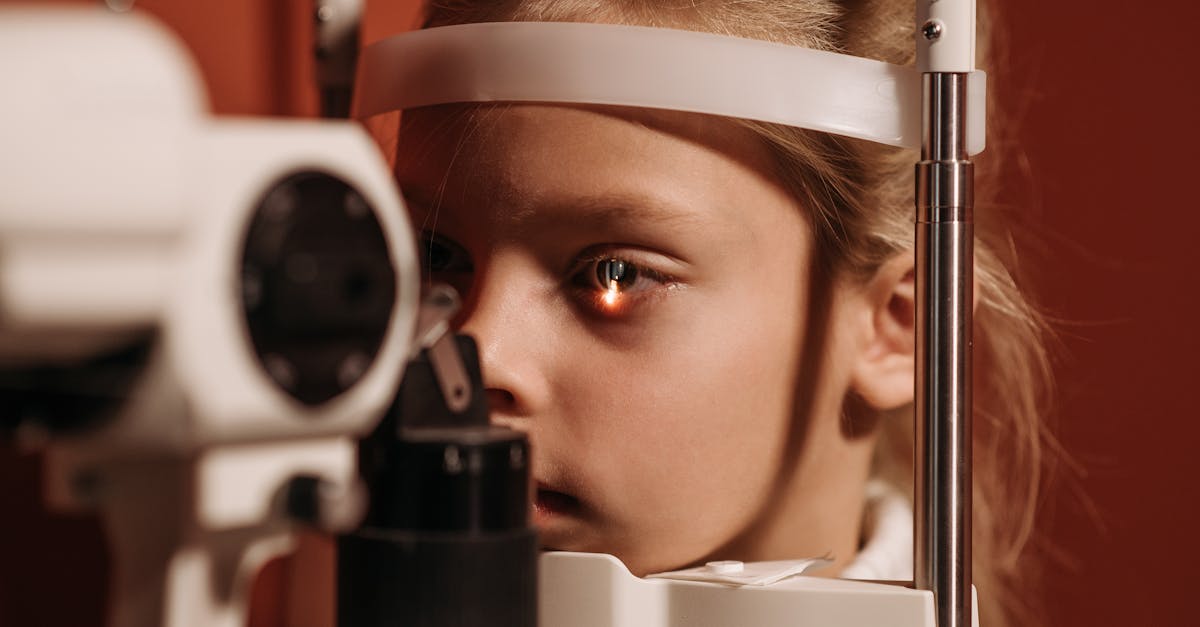Picking the right lenses for your glasses is about more than just seeing clearly—it's about making your entire world come into sharp, comfortable focus. The options can seem endless, from straightforward single-vision lenses to sophisticated progressives that handle everything at once. Each one is engineered for a specific purpose, designed to fit your unique vision and the life you lead. Finding the best pair of eyeglasses in Glendale Heights starts with understanding the technology behind the lenses, and our team at iDoctor is here to guide you every step of the way.
Your Guide to Eyeglass Lenses in Glendale Heights
Let's be honest, navigating the world of eyeglass lenses can feel a bit daunting at first. But it doesn't have to be. Think of this guide as a clear, simple map to understanding the technology behind your vision, helping you make a great choice right here in Glendale Heights. Whether your daily routine involves driving down Bloomingdale Road or spending hours in front of a computer screen, the right lenses make all the difference.
It's no surprise that the demand for quality eyewear is on the rise. The global market, valued at roughly $158.53 billion in 2024, is expected to soar to nearly $288.83 billion by 2033. A huge part of that growth comes from people just like you, with prescription glasses accounting for a massive 42% of the entire market. This just goes to show how many of us depend on our glasses every single day.
Here at iDoctor, we see lens selection as a deeply personal process, just as important as finding the perfect frames. As the premier eye doctor in Glendale Heights, our job is to break down the options in simple, approachable language, taking the mystery out of the technology so you can work with our team to find exactly what you need. We'll walk you through everything, from the basic lens designs to the high-tech coatings that protect your eyes and sharpen your view.
The perfect pair of glasses is a combination of two critical elements: a frame that fits your face and style, and lenses that are perfectly suited to your prescription and daily life. Neglecting one for the other can lead to discomfort and subpar vision.
Before we get into the nitty-gritty of lens types, remember that the frame you choose plays a huge role. A well-fitting frame not only looks fantastic but also provides the right support for your specific lenses. For a little more help on that front, take a look at our guide on how to choose prescription glasses that fit your face shape.
Now, let's dive into the technology inside the lenses themselves.
Understanding Foundational Lens Designs
When you're choosing new glasses, the journey starts with the basic lens designs—the trusted workhorses that solve the most common vision problems. These are the core technologies that all modern eyewear is built on, and for most people, the first stop is the familiar single vision lens.
Think of a single vision lens as one clear, consistent window that’s custom-tuned to help you see perfectly at one specific distance. It’s designed for a single job: correcting your vision for things far away (nearsightedness), up close (farsightedness), or an astigmatism. Their biggest advantage is their simplicity, giving you a wide, uninterrupted field of view for whatever you’re focused on.
Lenses With Multiple Powers
But what happens when you need help seeing at more than one distance? That's when multifocal lenses, like bifocals and trifocals, step in. Instead of one seamless window, these lenses are more like having distinct, separate panes for different distances.
- Bifocal Lenses: You've probably seen these before. They have two viewing areas separated by a visible line. The larger top section is usually for distance, while the smaller segment at the bottom is for reading or other close-up work.
- Trifocal Lenses: Going one step further, trifocals have three zones, also with visible lines. They correct for distance, intermediate vision (think a computer screen on your desk), and near vision for reading.
For many of our Glendale Heights clients who prefer having very clear, defined zones for their tasks, these classic designs are still a fantastic and reliable choice.
This infographic gives a great visual of how a lens can be divided to correct vision at multiple distances.
The image actually hints at a smoother transition between zones, which is a perfect lead-in to the more modern lens designs we'll get into next.
There’s no question that the need for these vision solutions is growing. The global prescription lens market was valued at over USD 51 billion in 2025 and is expected to climb as high as USD 97 billion by 2034. This boom is driven by more people needing to correct common refractive errors, which really highlights just how crucial these foundational single vision and bifocal designs are. Discover more insights about the prescription lens market.
These foundational lenses really are the building blocks of vision correction. Once you understand them, it’s much easier to appreciate the more advanced options and specialized coatings out there today.
For instance, any of these lens types can be upgraded with treatments like photochromic technology, which lets them darken automatically when you go outside. If you’ve ever wondered how those "two-in-one" lenses work, you might find our article on the pros and cons of photochromic lenses helpful.
Next up, we'll dive into a more modern, seamless approach to multifocal vision correction.
Exploring Modern Progressive Lenses
Think of bifocals as a staircase—you take a distinct step up or down to change your focus. Progressive lenses, on the other hand, are more like a smooth, seamless ramp. This is why they've become one of the most popular choices for eyeglass lenses today. They provide a gradual, line-free transition between seeing far away, at an intermediate distance (like a computer screen), and up close.
The result? A much more natural and uninterrupted way of seeing the world.
Unlike bifocals, progressives have no visible lines or segments. This gives them a clean, modern appearance that looks fantastic with the designer frames we carry here in Glendale Heights, from classic Cartier to bold Tom Ford styles. Your vision just flows, whether you're looking up at a street sign on North Avenue, glancing at your car's dashboard, or reading a text message on your phone.
Adapting to a Seamless View
For first-time wearers, there's a short learning curve while your brain and eyes get used to the different zones in the lens. It's a bit like breaking in a new pair of shoes; it just takes a little time. Most people feel completely comfortable within a few days to a couple of weeks.
The trick is to learn to point your nose, not just your eyes, at whatever you want to focus on. This simple habit ensures you're looking through the right part of the lens for the sharpest view. We've put together a more detailed guide if you want to dive deeper into how progressive lenses provide seamless vision correction.
A great experience with progressive lenses hinges on two critical factors: a highly accurate prescription from a thorough eye exam and a precision fitting by an experienced optician. The measurements have to be perfect to align the lens's viewing zones with your eyes.
At iDoctor, our Glendale Heights team takes incredibly precise measurements, making sure your new progressive lenses are customized perfectly for your vision and your chosen frames. This attention to detail is what makes all the difference, leading to a smooth adjustment and fantastic vision.
Here are a few quick tips to help you adapt:
- Point Your Nose: Instead of just moving your eyes, turn your head and point your nose at what you want to see. For reading, you'll naturally drop your chin and look through the bottom of the lens. For distance, look straight ahead.
- Be Careful with Stairs: When you're going up or down stairs, remember to tuck your chin down. This allows you to look through the top part of your lenses (for distance) to see the steps clearly.
- Wear Them All the Time: The fastest way to get used to your new glasses is to wear them consistently. Constantly switching back to an old pair will only slow down the process.
How to Choose the Right Lens Material
Once we've figured out the right lens design for your vision, the next big decision is the material itself. The stuff your lenses are made of is a huge factor in their weight, how tough they are, and even how they look. It’s a bit like choosing the right type of glass for a window—some are built for strength, while others are all about that sleek, barely-there appearance.
Trust me, the material is just as important as the prescription when it comes to your comfort, safety, and how much you'll love your new glasses. Let’s break down two of the most popular and effective materials we recommend to our patients here at iDoctor.
Polycarbonate for Safety and Durability
Think of polycarbonate lenses as the heavyweight champion of eyewear safety. This material wasn't even invented for glasses—it was originally developed for aerospace applications! That should tell you how incredibly tough it is.
Polycarbonate is impact-resistant and up to 10 times stronger than standard plastic lenses. This incredible durability makes it our number one recommendation for kids' eyewear, safety glasses, and anyone who leads an active life. If you're into sports or just a little clumsy, this is your material.
But its strength isn't the only benefit. Polycarbonate is also much lighter and thinner than basic plastic, making it comfortable for all-day wear. It even provides built-in sun protection by naturally blocking 100% of harmful UV rays. It's just a fantastic, all-around reliable choice.
High-Index for a Sleek and Slim Look
Now, if you have a stronger prescription, high-index lenses are where you want to be. This is the "sleek and slim" option. It's a more advanced material specifically engineered to bend light more efficiently than its standard counterparts.
What does this mean for you? Simply put, your lenses can be made dramatically thinner and lighter, even with a high prescription. It's how we eliminate that thick, distorting "coke-bottle" look that can make your eyes appear smaller and really limit your frame options.
High-index lenses are the perfect match for the curated designer eyeglasses in Glendale Heights we carry at iDoctor. When you're investing in a sophisticated frame from Cartier, Gucci, or Oliver Peoples, you want the lenses to complement the design, not overpower it. High-index lenses ensure your eyewear looks just as sharp as it helps you see.
Still not sure which way to go? To help you decide, we put together a detailed guide comparing high-index vs. standard lenses for designer frames. Making the right material choice ensures your new glasses are functional, comfortable, and a stylish reflection of you.
Upgrading Your Vision with Advanced Lens Coatings
Think of lens coatings as powerful, personalized upgrades for your glasses. Just as you might add special features to a new car, these treatments enhance your lenses to tackle the specific demands of your daily life, making your vision clearer, safer, and much more comfortable.
The single most important upgrade for almost everyone is an anti-reflective (AR) coating. This treatment does an incredible job of cutting down the distracting glare that bounces off digital screens or reflects from the headlights of oncoming cars at night. By getting rid of those reflections, AR coatings make your vision noticeably sharper and help reduce eye strain, which is why we recommend them so highly.
Treatments for Durability and Convenience
Beyond just glare, other coatings add layers of tough protection and smart functionality. A scratch-resistant coating is an absolute must-have. It acts like a durable, invisible shield to protect your investment from the inevitable drops, scuffs, and cleanings of daily life. It’s a simple addition that keeps your view crystal clear for much longer.
Another incredibly popular and convenient option is a photochromic treatment, often known by brand names like Transitions. These lenses are the ultimate two-in-one solution for anyone who moves between indoors and outdoors.
Imagine your everyday eyeglasses and your favorite sunglasses seamlessly combined into a single, intelligent pair. Photochromic lenses automatically darken when exposed to UV light and then quickly fade back to clear the moment you step inside. You get constant comfort and protection without ever having to switch frames.
A Breakdown of Lens Coatings and Their Benefits
To make it even clearer, here’s a quick look at how these common lens treatments work and who they’re designed for.
| Coating or Treatment | Primary Function | Perfect For |
|---|---|---|
| Anti-Reflective (AR) | Reduces glare from light sources and reflections on the lens surface. | Night drivers, computer users, and anyone wanting the clearest vision possible. |
| Scratch-Resistant | A hard, protective layer that prevents minor scratches and scuffs. | Everyone—especially kids, active individuals, and those who work in demanding environments. |
| Photochromic | Lenses that automatically darken in UV light and lighten indoors. | People who want the convenience of glasses and sunglasses in one pair. |
| Blue-Light Filtering | Filters a portion of high-energy blue light from digital screens. | Office workers, students, and anyone who spends significant time on computers or phones. |
These options allow you to build a pair of glasses that truly fits your lifestyle.
Protecting Your Eyes in a Digital Age
Let's face it, we spend more time on computers and smartphones than ever before. All that screen time bombards our eyes with high-energy visible (HEV) light, commonly known as blue light. For many, this leads to digital eye strain, nagging headaches, and even disrupted sleep patterns. This is a real concern for students at local schools like Glenbard North High School and for professionals all across Glendale Heights.
Blue-light filtering lenses were designed specifically for this challenge. They work by selectively filtering out a portion of the blue light that screens emit, which can ease eye fatigue and make those long hours in front of a device much more comfortable. This makes them a vital upgrade for anyone in our community whose work or education is screen-heavy. The demand for these specialized solutions is huge; the global optical lens market is projected to reach USD 39.58 billion by 2032. You can find out more about the growth of the optical lens market and see just how important this technology has become.
Knowing what these coatings can do for you is the first step toward customizing your eyewear for your exact needs. To dig a little deeper into how one of the most essential treatments works, we encourage you to learn more about the benefits of anti-reflective coatings in our detailed guide.
Let Us Help You Find Your Perfect Lenses at iDoctor
Knowing about the different kinds of lenses is a great start, but it's only half the battle. The next, most important step is getting a professional recommendation built around you.
Here at iDoctor, we’ve been serving Glendale Heights and the greater Chicagoland area for years. We combine our deep optical knowledge with the critical information we gather from our detailed eye exams in Glendale Heights. This comprehensive approach is how our team pinpoints the perfect lens solution for your specific vision and lifestyle.
Your Vision is Personal, Your Lenses Should Be Too
Choosing the right lenses isn't a one-size-fits-all process. It’s deeply personal. That's why we take the time to get to know you and what you need. We look at everything:
- Your exact prescription and vision requirements.
- Your lifestyle and daily routines—how much time you spend on the computer, driving, or enjoying your hobbies.
- Your personal style and the frames you've picked out.
Whether you've fallen for a classic pair of Ray-Ban sunglasses or a standout, high-fashion Fendi frame, we'll make sure your lenses are the perfect fit. Our job is to match you with the right material, design, and coatings that feel like they were made just for you.
Your vision is as unique as your fingerprint. A generic, off-the-shelf solution simply can't account for the countless ways you see and interact with the world every single day.
Come on in and see the difference for yourself. We invite you to schedule a consultation at our Glendale Heights boutique to experience how truly personalized care can change the way you see.
Our team is ready to help you see your world with stunning clarity. And to make things easier, iDoctor accepts all major vision insurance plans, ensuring premium eye care is always within reach. Don't put off getting the sharp, comfortable vision you deserve.
FAQs about Eyeglass Lenses in Glendale Heights
It's completely normal to have questions when picking out new lenses—there are so many options to sort through! To make things a little easier, we’ve gathered some of the most common questions we hear from our Glendale Heights patients. Our goal is to cut through the confusion and help you feel totally confident in your choice.
Which lens material is best for designer frames?
For the luxury and designer frames we offer, such as Cartier, Tom Ford, and Gucci, we almost always recommend high-index lenses. Because they are thinner and lighter, they complement the sophisticated, often delicate, designs of these frames without adding bulk or distorting your eyes. This ensures your investment in a high-end frame looks its absolute best. We’ll help you find the perfect pair of designer eyeglasses in Glendale Heights.
Do you offer lenses for both adults and children?
Absolutely. We provide comprehensive lens solutions for the entire family. For children, we strongly recommend polycarbonate lenses due to their superior impact resistance and built-in UV protection, which are essential for keeping young eyes safe during play. For adults, the choice depends on prescription and lifestyle, but we have options for every need.
How do I know if I need blue-light filtering lenses?
If you spend several hours a day on a computer, tablet, or smartphone—which is common for students at Glenbard North High School or professionals working from home in the area—you are an excellent candidate for blue-light filtering lenses. During your consultation, tell us about your daily screen time, and we can determine if this upgrade will help reduce eye strain and improve your comfort.
At iDoctor, we’re here to walk you through every step, making sure your new lenses and frames are the perfect match for you. From finding Cartier glasses near you to fitting the perfect contact lenses in Glendale Heights, our team is dedicated to providing the best vision care in the area.

